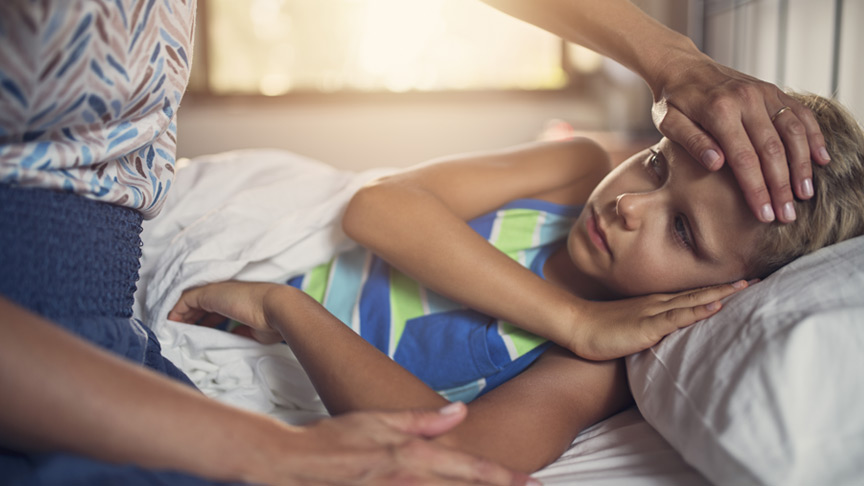
It starts with a sneeze, a scratchy throat - or maybe a cough that won’t quit. Before you know it, your child is curled up on the couch with a fever, and you’re left wondering: What is this, and what should I do?
Knowing what to look for can help you respond confidently - whether that means managing symptoms at home, seeing your General Practitioner (GP), or seeking urgent care.
What are the most common winter illnesses?
Although children can catch viruses year-round, winter often feels like a never-ending cycle of sniffles and sickness. Typically, young children can have up to 12 viral infections each year, but this number usually drops as they get older and their immune system becomes stronger.
The common cold, influenza, and respiratory syncytial virus (RSV) are seasonal and most common during the winter months. Usually COVID-19 cases also peak during the winter season.
- Rhinovirus is a virus that primarily affects the nose, throat, and upper airways, and is the most frequent cause of the common cold. Symptoms tend to be mild and get worse over a few days before they resolve.
- COVID-19 is a viral illness that can affect the nose, throat and lungs. It spreads when people breathe in or touch droplets that carry the virus. This virus belongs to the same family as the common cold.
- Influenza (flu) is a viral illness that is easily spread from person to person, mainly through particle droplets produced by coughing and sneezing. Influenza is most often caused by type A or B influenza viruses that infect the upper airways and lungs.
- Parainfluenza refers to a group of viruses called human parainfluenza viruses (HPIVs). There are four viruses in this group, each one causing different symptoms and illnesses. All forms of HPIV cause an infection in either the upper or lower respiratory tract.
- Respiratory Syncytial Virus (RSV) is a virus that can cause inflammation and mucous to build up quickly in children’s airways which can make it hard to breathe and cause lung infections, such as bronchiolitis and pneumonia.
What are the signs and symptoms?
Winter can feel like a revolving door of viruses. Symptoms often overlap and it can be tough to tell common illnesses apart.
Each child is different and may show a variety of symptoms, including varying degrees of illness.
Rhinovirus may include a runny or stuffy nose, sneezing, sore throat, and mild cough.
COVID-19 symptomscommonly include fever, cough, fatigue, sore throat, and loss of taste or smell.
Influenza often presents suddenly with high fever, body aches, fatigue, sore throat, and cough.
Parainfluenza can cause symptoms like cough, hoarseness, fever, and in children, it’s a leading cause of croup.
RSV (Respiratory Syncytial Virus) frequently leads to congestion, coughing, wheezing, and sometimes difficulty breathing, especially in infants.
What are the treatment options?
For mild cases of these common illnesses, most children and young people can be safely cared for at home until they recover.
Most symptoms can generally be managed by:
- Plenty of rest.
- Keeping fluids up - encourage water, as well as drinks like juice or cordial to help maintain energy, especially if your child isn’t eating as much as usual.
- Using over-the-counter medications like paracetamol or ibuprofen to relieve pain, fever, and discomfort (always follow the directions on the label).
As most common colds, flu, COVID-19 and RSV are viral infections, antibiotics are not typically the most effective treatment.
When should I seek help?
In an emergency, call Triple Zero (000) and ask for an ambulance, especially if your child has:
- trouble breathing or talking
- chest pain or a racing heart
- has blue-coloured lips or skin
- is not eating or drinking and/or has fewer wet nappies than usual
- is extremely irritable.
If you're not sure whether to go to an emergency department, call 13 HEALTH (13 43 25 84) and speak to a registered child health nurse.
Stopping the spread
If your child is unwell, it’s important that you take steps to minimise the risk of spreading the virus to others, especially those who are high risk of serious complications.
Follow the steps below to reduce the risk of spreading flu or cold viruses:
- Encourage regular handwashing with soap and water for at least 20 seconds.
- Teach your child to cover their mouth and nose with a tissue or their elbow when they cough or sneeze.
- Provide hand sanitizer for situations where handwashing isn’t possible.
- Remind your child not to share personal items like towels, utensils, or drinks.
- Keep surfaces and frequently touched objects clean and disinfected.
- Keep your child at home if they are feeling unwell to prevent spreading germs to others.
Prevention plays an important role in keeping the community safe, and immunisation is a simple and effective way of protecting children from serious diseases. These diseases can be prevented by routine childhood immunisation and are included in the National Immunisation Program (NIP) Schedule.